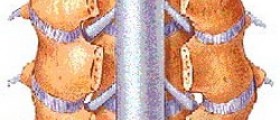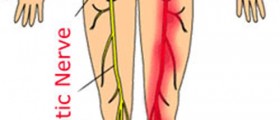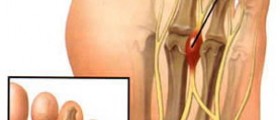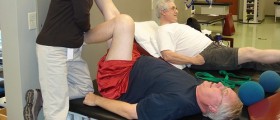People experience leg pains in various ways. Some may have dull, aching pains, accompanied by heaviness, while others experience cramping, burning or numbing type of discomfort. There are many possible reasons for leg pain and these may involve the muscles, bones, nerve, blood vessels of the legs and even the lower back.
Muscle Cramps
The muscles of the legs can cramp and cause severe pain, which may be due to muscle fatigue or overuse, dehydration, or intake of certain medicines like statins (anti-cholesterol drugs) and diuretics.

Leg Injury
Torn muscles, torn ligaments, inflammation of a tendon (tendinitis), hairline fracture on the leg bone, and shin splints (due to overuse of the lower leg) can cause severe leg pains and must be given immediate treatment. These leg injuries are common and usually due to overuse from sports or work.
Degenerative Changes in the Spine
Degenerative changes naturally occur as people age and these may manifest in various ways. In some people the discs between the vertebrae of the spine (intervertebral discs) become dehydrated and lose their flexibility, causing low back pain. This pain may radiate towards the leg and foot (often called referred pain), causing dull, aching pain in the legs.
A herniated intervertebral disc can cause pinching of spinal nerves, leading to severe pain in the lower back and in the legs. This can sometimes cause disability until compression of the nerve roots is relieved.
Degeneration and inflammation can also cause spinal stenosis, which chokes the nerve roots and causes low back pains that radiate to the legs. Pain may worsen with sitting or standing and may be relieved by a change in position, such as bending over.
Another cause of nerve root compression is spondylolisthesis, where an unstable vertebra slips to the next vertebra, causing lower back and leg pains.
The nerves involved in these conditions form the sciatic nerve, which extends from the hip to the leg, causing a condition generally referred to as sciatica. The pain may be characterized as a constant burning pain or a shooting type of pain.
Other people who have low back pains also experience numbness or tingling in the legs, which may also be associated with nerve root compression. A few individuals may experience heaviness or weakness (foot drop), which significantly interferes with movement. One may have a feeling of having to drag the lower leg and the foot while walking and climbing stairs.
Problems in the Blood Vessels
Problems with either the veins or arteries in the legs can also cause leg pains. For example, people who have atherosclerosis (hardening and narrowing of the arteries) may experience claudication, or leg pain when walking, which is relieved by rest. Large and inflamed varicose veins can also cause leg pains, as well as blood clots from deep vein thrombosis. Peripheral arterial disease associated with diabetes, smoking, high cholesterol and high blood pressure may also lead to leg pains.
Other Causes
One complication of type 2 diabetes in diabetic neuropathy, or nerve damage due to uncontrolled blood sugar levels. This may affect the leg and foot nerve, causing both pain and numbness.
Inflammation of the knee and ankle joints may also be perceived as leg pains and these may be caused by osteoarthritis or gout.
Less common causes of leg pain include infection of the bone (osteomyelitis), infection of soft tissues (cellulitis), benign tumors (osteoma), and cancer (osteosarcoma).
- WebMD. Lower Leg Pain Causes and Treatments. http://www.webmd.com/pain-management/guide/lower-leg-pain-causes-and-treatments
- Medline Plus. Leg Pain. http://www.nlm.nih.gov/medlineplus/ency/article/003182.htm
- Spine Health. Causes of Leg Pain and Foot Pain. http://www.spine-health.com/conditions/leg-pain/leg-pain-and-numbness-what-might-these-symptoms-mean
- Photo courtesy of SteadyHealth
















